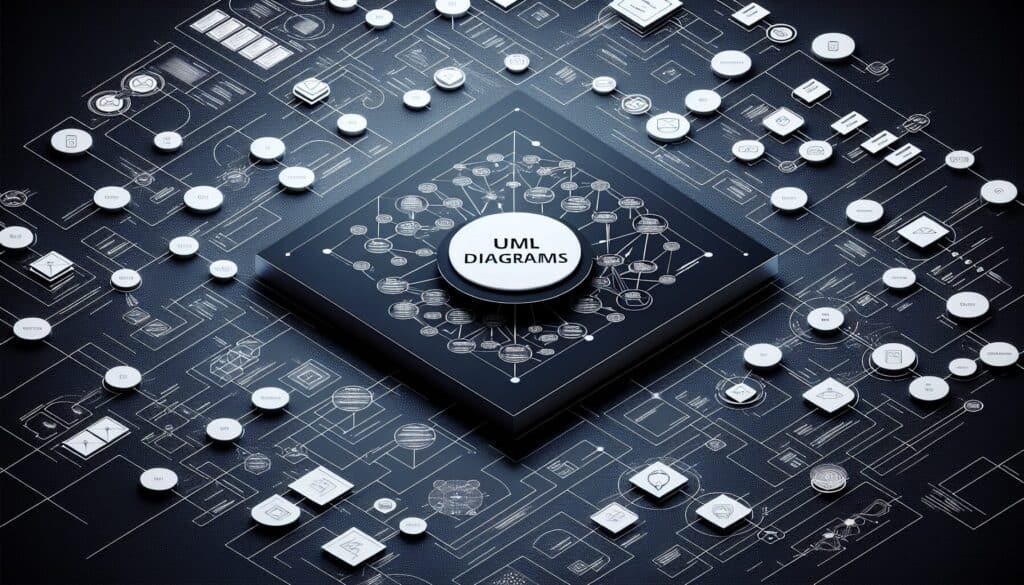To provide a standard way to visualize the design of a system.
- Metodologías: Clientes y marketing, Economía, Lean Sigma, Fabricación, Gestión de proyectos, Calidad
Diagramas UML

Diagramas UML
- Documentación de diseño, Proceso de diseño, Pensamiento de diseño, Gestión de proyectos, Sistema de Gestión de Calidad (SGC), Kit de desarrollo de software (SDK), Ingeniería de software, Lenguaje de modelado de sistemas (SysML), Lenguaje Unificado de Modelado (UML)
Objetivo:
Cómo se utiliza:
- Uses a set of graphical notations to create visual models of software systems, including their structure, behavior, and interactions. Different types of UML diagrams (e.g., class, sequence, use case) serve different purposes in the software development lifecycle.
Ventajas
- Standardized and widely understood; Improves communication among stakeholders; Helps in identifying potential flaws early in the design process; Supports various stages of software development.
Contras
- Can be complex and time-consuming to create and maintain, especially for large systems; Some diagrams can be difficult for non-technical stakeholders to understand; Risk of over-modeling or creating unnecessary diagrams.
Categorías:
- Ingeniería, Diseño de producto, Gestión de proyectos
Ideal para:
- Visualizing, specifying, constructing, and documenting the artifacts of a software-intensive system.
UML (Unified Lenguaje de modelado) diagrams serve as a foundational tool in software engineering, providing a graphical representation of various aspects of systems that enhances both understanding and documentation. They are utilized extensively across industries such as aerospace, automotive, healthcare, and information technology to depict everything from system architecture to process flows and user interactions. For instance, in the healthcare sector, use case diagrams can illustrate patient interaction with medical software systems, while class diagrams can detail the underlying database structures. Various stakeholders such as business analysts, developers, project managers, and system architects engage with UML diagrams during critical phases of a project, such as requirements gathering, system design, and during the implementation of Agile and DevOps methodologies. This collaborative approach facilitates effective communication, ensuring that technical and non-technical team members align on project goals and specifications. The standardization brought by UML also aids new team members or cross-functional teams in quickly assimilating project knowledge, as the visual representation provides an intuitive understanding of the system’s components and their relationships. Beyond visualization, UML diagrams assist in modeling dynamic behaviors and interactions among different system parts, helping to identify potential design flaws, inefficiencies, or areas of risk early in the development cycle. Additionally, the broad acceptance of UML across various educational platforms enhances the ease of creating interchangeability within teams, aiding in smoother transitions between phases like design to implementation or testing.
Pasos clave de esta metodología
- Identify the purpose and scope of the system.
- Define the key stakeholders and their requirements.
- Select appropriate UML diagrams for representation.
- Create use case diagrams to outline interactions and functionalities.
- Develop class diagrams to illustrate system structure and relationships.
- Produce sequence diagrams to detail object interactions over time.
- Refine diagrams based on feedback and iterative review.
- Ensure diagrams are up to date with design changes.
- Integrate UML diagrams into system documentation.
- Utilize diagrams for code generation and testing phases.
Consejos profesionales
- Utilize stereotypes and tagged values in class diagrams to provide additional semantic clarity, enhancing communication about model specifics.
- Employ sequence diagrams to validate interactions, ensuring that all use case scenarios are captured, which can reveal hidden dependencies among components.
- Incorporate iterative feedback loops with stakeholders during UML diagram reviews to align expectations and uncover design flaws earlier in the lifecycle.
Leer y comparar varias metodologías, recomendamos el
> Amplio repositorio de metodologías <
junto con otras más de 400 metodologías.
Sus comentarios sobre esta metodología o información adicional son bienvenidos en la dirección sección de comentarios ↓ , así como cualquier idea o enlace relacionado con la ingeniería.
Contexto histórico
1828
1850
1854
1854
1911
1928
1950
1827
1848
1850
1854
1895
1914
1943
1970
(si se desconoce la fecha o no es relevante, por ejemplo "mecánica de fluidos", se ofrece una estimación redondeada de su notable aparición)















Publicaciones relacionadas
Simulación de Monte Carlo
Pruebas basadas en modelos
Comprobación de modelos
Investigación con métodos mixtos
A prueba de errores (Poka-Yoke)
Pruebas del perfil de la misión